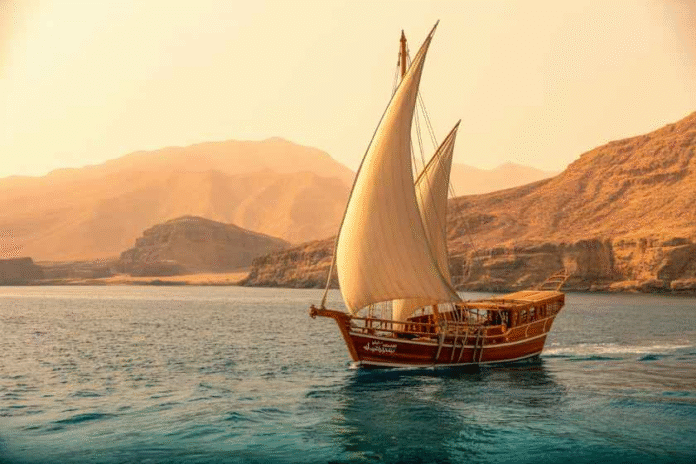Rising dramatically above Muscat’s harbour, Al Mirani Fort has reopened its gates to visitors after an extensive restoration, reaffirming its role as one of Oman’s most enduring cultural landmarks. The 16th-century fortress, once a cornerstone of Portuguese maritime power and later a symbol of Omani resistance, now welcomes travellers eager to explore the nation’s layered history against a backdrop of sweeping coastal views.
The reopening, marked in April 2025, reflects the Sultanate’s broader cultural tourism strategy: to preserve architectural heritage while presenting it as a gateway to understanding Oman’s evolving identity. For international guests, entry is set at Dh95, with the site open daily from 8:00 a.m.
A Strategic Outpost Turned National Symbol
Built by the Portuguese in the late 1500s, Al Mirani Fort was designed to control access to Muscat’s natural harbour—a maritime hub critical to trade in spices, pearls, and copper. With its commanding vantage point over the Gulf of Oman, the fort became both a physical barrier and a symbol of foreign domination.
In 1650, Omani forces launched a decisive campaign to reclaim their coast, successfully expelling the Portuguese. That moment marked not only the end of colonial control but also the beginning of Oman’s ascendance as a maritime power. For centuries thereafter, Al Mirani Fort served as a royal garrison and defensive stronghold, its cannons trained on the sea while its walls sheltered generations of Omani soldiers.
Today, its fusion of Portuguese granite, Omani stonework, and Persian decorative elements testifies to the confluence of cultures that passed through Muscat’s shores.
The Visitor Experience: Walking Through Centuries
With its meticulous restoration now complete, Al Mirani Fort invites travellers to engage with history through both preserved architecture and modern interpretive design. Visitors can:
Explore fortified chambers once used as barracks and storage.
Climb crenellated ramparts offering panoramic views of Muscat’s skyline and the Arabian Sea.
Engage with exhibitions narrating the fort’s military role, the Portuguese occupation, and Oman’s eventual liberation.
Experience immersive displays that recreate 17th-century naval conflicts and daily life within the fort’s walls.
Perhaps the most compelling moment awaits at the summit, where the juxtaposition of Muscat’s modern cityscape and the weathered stone of Al Mirani encapsulates the dialogue between Oman’s past and present.
A Pillar of Oman’s Heritage Tourism Strategy
The reopening of Al Mirani Fort is part of a national effort to highlight Oman’s cultural heritage as a tourism driver. Alongside UNESCO World Heritage Sites and an expanding network of castles, museums, and archaeological parks, the fort underscores the Sultanate’s determination to anchor its tourism offering in authenticity and history.
Government investment has been coupled with partnerships aimed at balancing preservation with accessibility, ensuring that heritage landmarks remain both protected and economically sustainable. As Oman’s visitor arrivals grow, such projects are positioned to attract travellers seeking cultural depth beyond beaches and resorts.
Practical Information for Visitors
Location: Central Muscat, easily accessible via car, taxi, or organised tours.
Hours: Open daily from 8:00 a.m.; visitors should confirm schedules in advance due to occasional closures.
Admission: Dh95 for international guests.
Best Experience: Sunset tours for panoramic photography and cooler evening breezes.
Conclusion: A Must-See for Cultural Travellers
The revival of Al Mirani Fort offers more than a glimpse into Oman’s architectural and military past; it is an invitation to witness how a nation reclaims its history as part of its modern identity. For travellers, the fort represents both a striking landmark and a living narrative of resilience, heritage, and maritime legacy.
Standing on its ramparts, with the Arabian Sea stretching into the horizon, one cannot help but sense the continuity of Oman’s story—a story in which Al Mirani remains both guardian and guide.
Other Forts Worth Exploring in Oman
Al Jalali Fort (Muscat): Al Mirani’s twin fortress across the harbour, once a Portuguese prison and later a royal garrison. Offers equally panoramic views and a compelling counterpoint to Al Mirani’s story.
Nizwa Fort: Built in the 17th century, it boasts the largest tower in Oman and serves as a cultural hub in the country’s interior.
Bahla Fort (UNESCO World Heritage Site): A sprawling adobe fortress and one of Oman’s oldest, offering a deep dive into pre-Islamic settlement patterns.
Khasab Castle (Musandam): A picturesque coastal fort showcasing Oman’s maritime heritage in the northern peninsula.
Quick Guide for Travellers
Best Time to Visit: October to April, when Muscat’s climate is mild.
Photography Tip: Visit at sunrise or sunset for dramatic shadows on the stone walls and breathtaking views of Muscat’s coastline.
Pair It With: A walking tour of Old Muscat, including the Sultan’s Palace and Muttrah Souq.
Accessibility: Moderate – requires climbing stairs and navigating uneven terrain; wear comfortable footwear.
Did You Know?
Al Mirani Fort played a decisive role in 1650, when Oman expelled the Portuguese—the event is widely regarded as the first major victory of an Arab power against European colonial rule in the Gulf.










